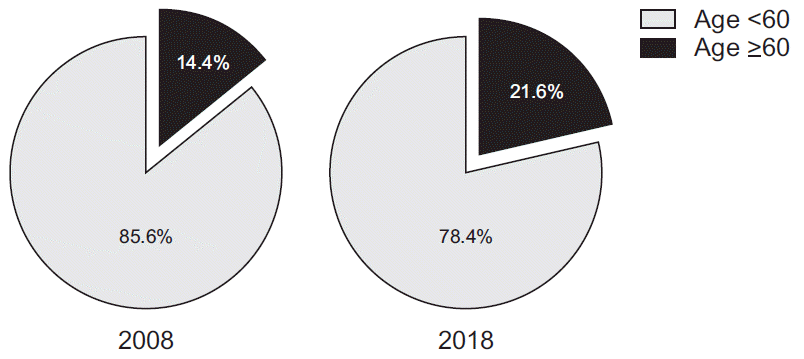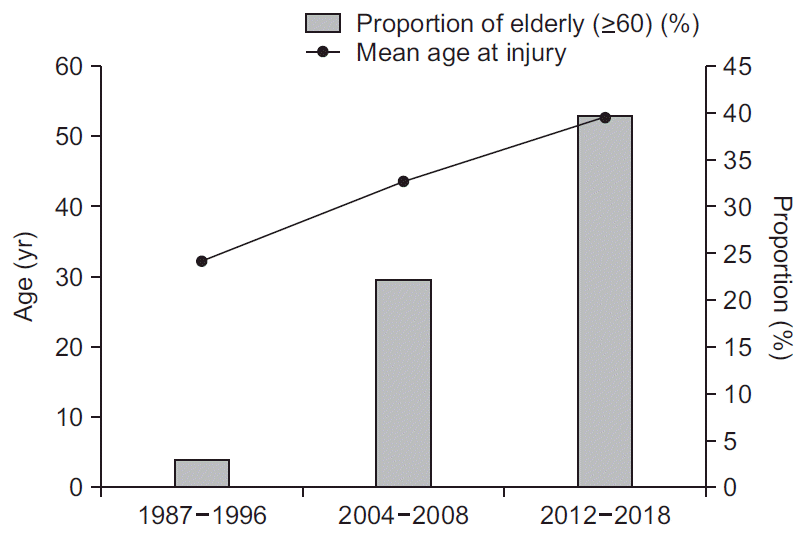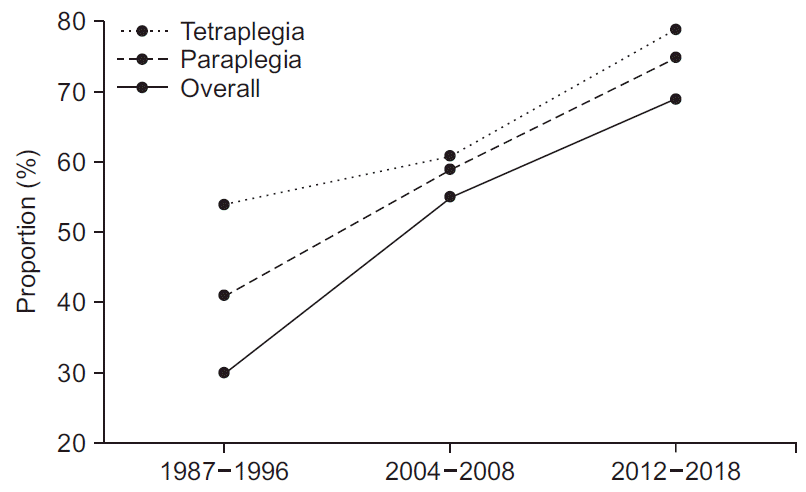1. DeVivo MJ. Causes and costs of spinal cord injury in the United States. Spinal Cord. 1997; 35:809–13.

2. Price C, Makintubee S, Herndon W, Istre GR. Epidemiology of traumatic spinal cord injury and acute hospitalization and rehabilitation charges for spinal cord injuries in Oklahoma, 1988-1990. Am J Epidemiol. 1994; 139:37–47.

3. Sekhon LH, Fehlings MG. Epidemiology, demographics, and pathophysiology of acute spinal cord injury. Spine (Phila Pa 1976). 2001; 26(24 Suppl):S2–12.

4. Sohn S, Kim J, Chung CK, Lee NR, Sohn MJ, Kim SH. A nation-wide epidemiological study of newly diagnosed primary spine tumor in the adult Korean population, 2009-2011. J Korean Neurosurg Soc. 2017; 60:195–204.

5. Pickett GE, Campos-Benitez M, Keller JL, Duggal N. Epidemiology of traumatic spinal cord injury in Canada. Spine (Phila Pa 1976). 2006; 31:799–805.

6. Cook DJ, Cusimano MD, Tator CH, Chipman ML. Evaluation of the ThinkFirst Canada, Smart Hockey, brain and spinal cord injury prevention video. Inj Prev. 2003; 9:361–6.
7. Shults RA, Sleet DA, Elder RW, Ryan GW, Sehgal M. Association between state level drinking and driving countermeasures and self reported alcohol impaired driving. Inj Prev. 2002; 8:106–10.

8. Wesner ML. An evaluation of Think First Saskatchewan: a head and spinal cord injury prevention program. Can J Public Health. 2003; 94:115–20.
9. Devivo MJ. Epidemiology of traumatic spinal cord injury: trends and future implications. Spinal Cord. 2012; 50:365–72.

10. DeVivo MJ, Chen Y. Trends in new injuries, prevalent cases, and aging with spinal cord injury. Arch Phys Med Rehabil. 2011; 92:332–8.

11. Jackson AB, Dijkers M, Devivo MJ, Poczatek RB. A demographic profile of new traumatic spinal cord injuries: change and stability over 30 years. Arch Phys Med Rehabil. 2004; 85:1740–8.

12. National Spinal Cord Injury Statistical Center. 2019 annual report - complete public version. Birmingham, AL: National Spinal Cord Injury Statistical Center;2019.
13. Ning GZ, Wu Q, Li YL, Feng SQ. Epidemiology of traumatic spinal cord injury in Asia: a systematic review. J Spinal Cord Med. 2012; 35:229–39.

14. Han ZA, Lee BS, Kim W, Lee SJ, Im HJ, Kim C, et al. People with spinal cord injury in Korea. Am J Phys Med Rehabil. 2017; 96(2 Suppl 1):S83–5.

15. Park CI, Shin JC, Kim SW, Jang SH, Chung WT, Kim HJ. Epidemiologic study of spinal cord injury. J Korean Acad Rehabil Med. 1999; 23:267–75.
16. Shin JC, Kim DH, Yu SJ, Yang HE, Yoon SY. Epidemiologic change of patients with spinal cord injury. Ann Rehabil Med. 2013; 37:50–6.

17. National Rehabilitation Center. National Rehabilitation Center SCI Database. Seoul, Korea: National Rehabilitation Center;2014.
18. Ackery A, Tator C, Krassioukov A. A global perspective on spinal cord injury epidemiology. J Neurotrauma. 2004; 21:1355–70.

19. Lee BB, Cripps RA, Fitzharris M, Wing PC. The global map for traumatic spinal cord injury epidemiology: update 2011, global incidence rate. Spinal Cord. 2014; 52:110–6.

20. Eurostat. Population structure and ageing 2008-2018. Luxembourg, Luxembourg: Eurostat;2018.
21. Statistics Korea. 2018 senior statistics. Daejeon, Korea: Statistics Korea;2018.
22. He W, Goodkind D, Kowal P. An aging world 2015. Washington, DC: US Census Bureau;2016.
23. Sohn S, Chung CK, Yun TJ, Sohn CH. Epidemiological survey of ossification of the posterior longitudinal ligament in an adult Korean population: three-dimensional computed tomographic observation of 3,240 cases. Calcif Tissue Int. 2014; 94:613–20.

24. Inamasu J, Guiot BH, Sachs DC. Ossification of the posterior longitudinal ligament: an update on its biology, epidemiology, and natural history. Neurosurgery. 2006; 58:1027–39.

25. Jin BH, Kim YS. Ossification of spinal ligaments. J Korean Neurosurg Soc. 1991; 20:875–84.
26. Fujimori T, Le H, Hu SS, Chin C, Pekmezci M, Schairer W, et al. Ossification of the posterior longitudinal ligament of the cervical spine in 3161 patients: a CT-based study. Spine (Phila Pa 1976). 2015; 40:E394–403.
27. Saetia K, Cho D, Lee S, Kim DH, Kim SD. Ossification of the posterior longitudinal ligament: a review. Neurosurg Focus. 2011; 30:E1.

28. Chamberlain JD, Deriaz O, Hund-Georgiadis M, Meier S, Scheel-Sailer A, Schubert M, et al. Epidemiology and contemporary risk profile of traumatic spinal cord injury in Switzerland. Inj Epidemiol. 2015; 2:28.

29. DeVivo MJ, Biering-Sorensen F, New P, Chen Y; International Spinal Cord Injury Data Set. Standardization of data analysis and reporting of results from the International Spinal Cord Injury Core Data Set. Spinal Cord. 2011; 49:596–9.

30. Knutsdottir S, Thorisdottir H, Sigvaldason K, Jonsson H Jr, Bjornsson A, Ingvarsson P. Epidemiology of traumatic spinal cord injuries in Iceland from 1975 to 2009. Spinal Cord. 2012; 50:123–6.

31. Halvorsen A, Pettersen AL, Nilsen SM, Halle KK, Schaanning EE, Rekand T. Epidemiology of traumatic spinal cord injury in Norway in 2012-2016: a registry-based cross-sectional study. Spinal Cord. 2019; 57:331–8.

32. Chen Y, Tang Y, Allen V, DeVivo MJ. Fall-induced spinal cord injury: external causes and implications for prevention. J Spinal Cord Med. 2016; 39:24–31.

33. Ministry of the Interior and Safety. Statistics of residence registration population 2008-2018. Sejong, Korea: Ministry of the Interior and Safety;2019.
34. Kim TJ, Bae KW, Uhm WS, Kim TH, Joo KB, Jun JB. Prevalence of ossification of the posterior longitudinal ligament of the cervical spine. Joint Bone Spine. 2008; 75:471–4.

35. Jain NB, Ayers GD, Peterson EN, Harris MB, Morse L, O’Connor KC, et al. Traumatic spinal cord injury in the United States, 1993-2012. JAMA. 2015; 313:2236–43.





 PDF
PDF Citation
Citation Print
Print






 XML Download
XML Download